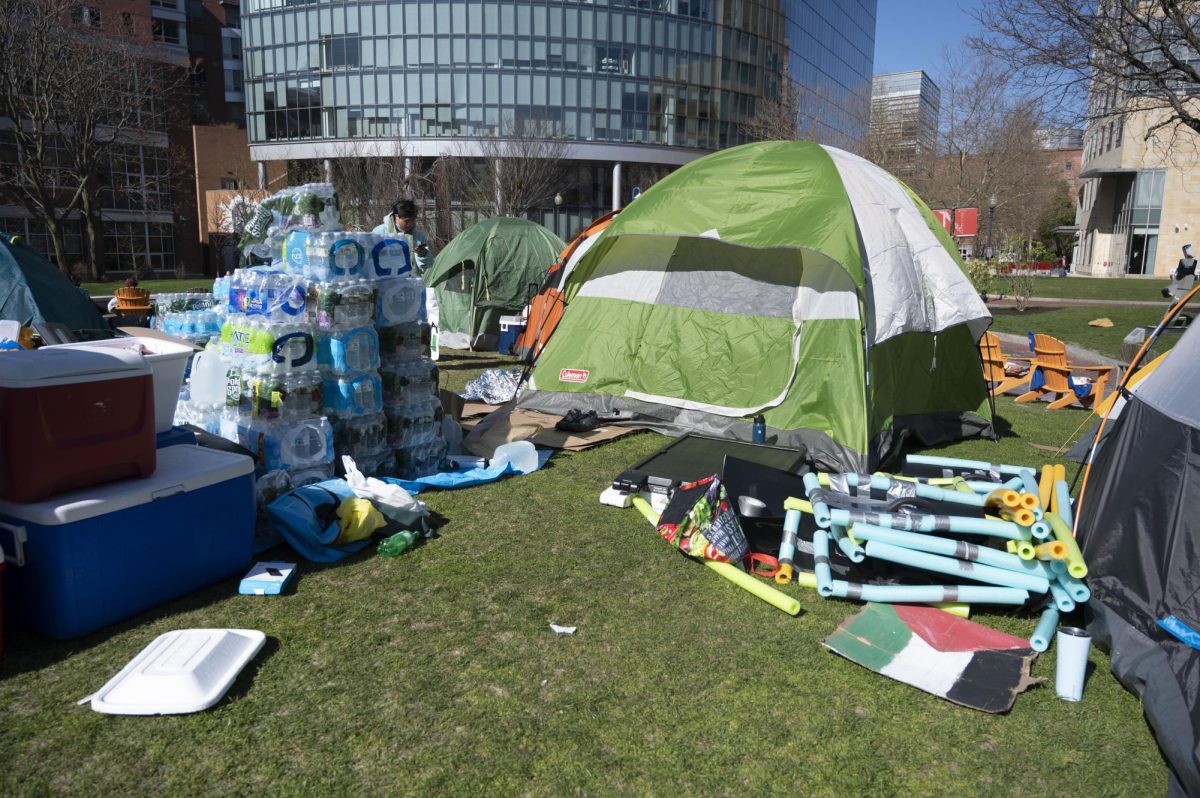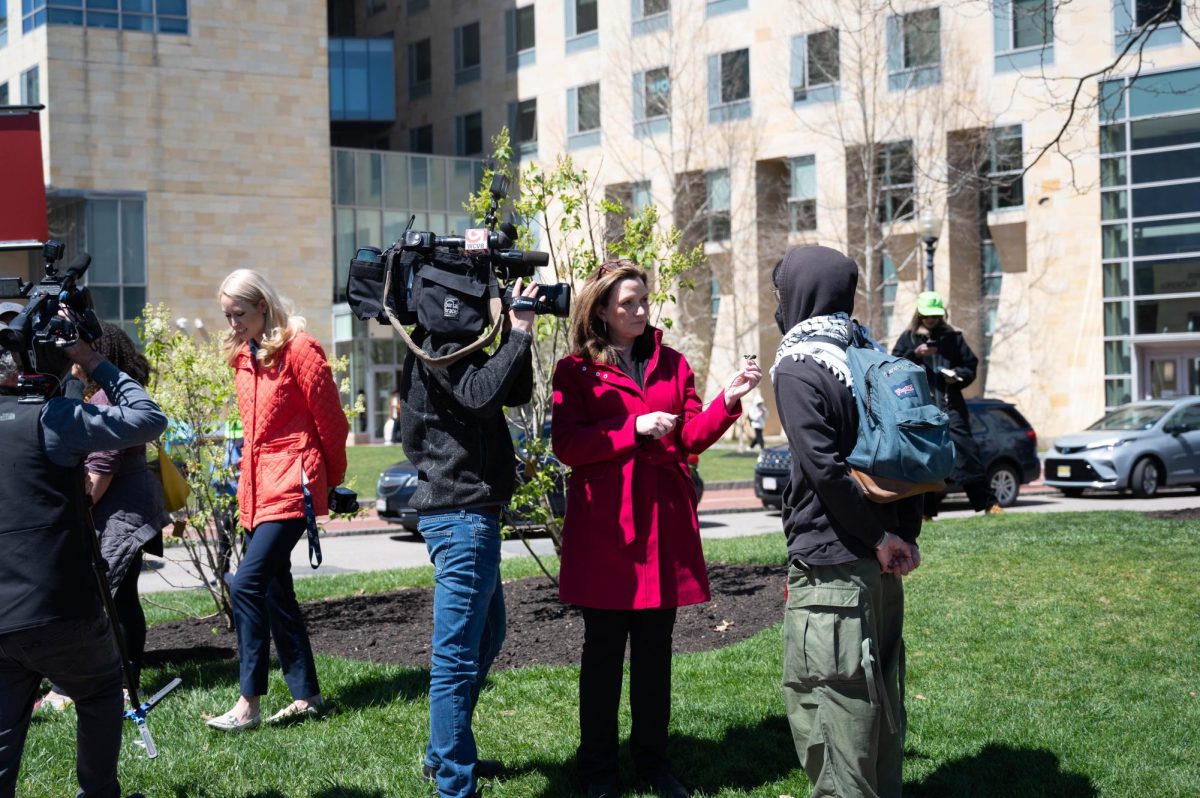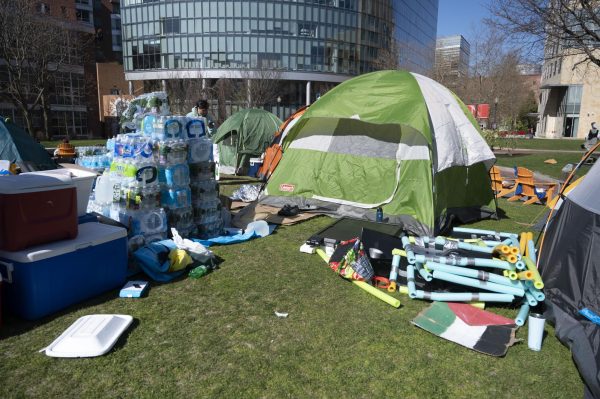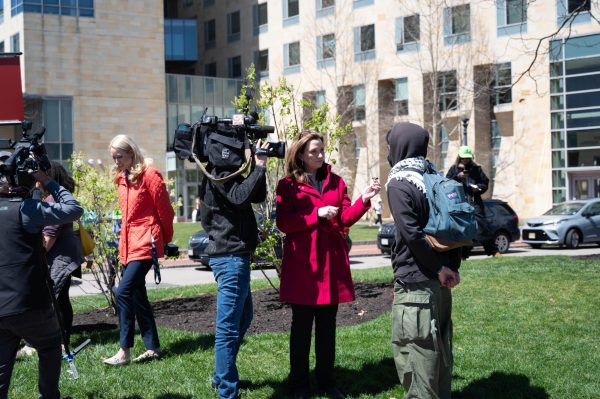Embrace monument brings to life MLK’s history, legacy in Boston Common
Hundreds gather to witness the unveiling of “The Embrace” in Boston Common Jan. 13. The sculpture honoring Dr. Martin Luther King Jr. was modeled off a photo of him and his wife, Coretta Scott King, who embraced after learning he won the 1964 Nobel Peace Prize.
February 5, 2023
New memorial art installations — especially those costing $10 million — are rare occasions in Boston. But for the first time in 30 years, a new memorial sculpture was unveiled in Boston Common Jan. 13.
“The Embrace,” designed by American conceptual artist Hank Willis Thomas and the MASS Design Group, is an inspired interpretation of the hug shared by Dr. Martin Luther King Jr. and Coretta Scott King, after learning he won the 1964 Nobel Peace Prize.
The Kings met and fell in love as students in Boston — Martin Luther King Jr. attended Boston University, and Coretta Scott King attended the New England Conservatory of Music. In late April 1965, Dr. King gave a speech on Boston Common following a march from Roxbury. The memorial is located adjacent to the Parkman Bandstand, where Martin Luther King Jr. addressed the crowd of 22,000.
Nearly 60 years later, on a misty Friday afternoon ahead of the unveiling, hundreds stood for hours in the muddy grass between the bandstand and the sculpture, listening to government and community leaders.
“This memorial means so much, the unveiling being MLK weekend and everything,” said Aja Jackson, an accountant and Roxbury resident. “This is just something Boston really needs, especially in Boston Common, to have representation of African Americans in Boston. MLK was a staple in Boston and he did a lot [here]. This is a great thing for me, and that’s why I came and attended.”
Members of the King family attended the unveiling. Martin Luther King III and his wife Arndrea Waters King spoke of the love the Kings shared. Martin Luther King Jr.’s only grandchild, 14-year-old Yolanda Renee King, shared words of optimism and hope with the crowd.
Massachusetts politicians of past and present joined.
“Equity in the permanent artistic DNA of this city’s infrastructure matters, especially in a city with a storied past, but an evolving and still-struggling present,” Congresswoman Ayanna Pressley said. “This is a day that has been a long time in the making that is only made possible due to a vision, an unrelenting commitment and the service of those who labored for many years to make it.”
Latoyia Edwards, an anchor with NBC10 Boston, emceed the unveiling.
“I could not imagine this as a woman who was once a little girl raised in the housing projects in Dorchester, just miles from this storied common,” Edwards said. “I am absolutely humbled and emotional to stand here on this stage as your emcee, because I am also standing on the shoulders of the many people of color in this city, like my mom, who was a kid during the school desegregation, getting pelted with rocks. … I represent those many people in Boston who passed away without seeing this promise come to life.”
The design of the memorial was selected by the King Boston Art Committee assembled in conjunction with Embrace Boston, the organization behind the monument, and the City of Boston.
Embrace Boston is a nonprofit first founded by tech entrepreneur Paul English. His co-chairs, the Rev. Liz Walker and the Rev. Jeffrey Brown, led the crowd in a prayer at the start of the ceremony. At the unveiling, Walker shared a story about the time she heard Martin Luther King Jr. speak.
“My father took me with him to Art Street Baptist Church in my hometown of Little Rock, Arkansas, to hear Dr. Martin Luther King Jr.,” she said. “It was probably after the successful Montgomery Bus boycott. Of course, I was too young to understand anything. All I knew is Daddy was gonna go see the king. I thought that was Jesus. So I better be there.”
The crowd laughed as she continued.
“I will never forget the electricity of that moment when ordinary people were inspired to take extraordinary measures in the name of love, not as a sentiment or a romance, but as a creative weapon of force for change,” Walker said.
Executive Director Imari Paris Jeffries broke down into tears when he stepped up to the podium to speak at the unveiling.
“I’m just so grateful to give something back to this city that gave me so much,” he said. “[This] is not only a symbol of the King’s legacy, but its embodiment of their love and the impact of the love within all of us.”
The 22-foot tall sculpture is made of 609 pieces of bronze and rests on a plaza of diamond shaped pavers engraved with quotes and the names of Boston civil rights leaders, called the 1965 Freedom Plaza. There are over 1,300 granite stone pieces in six different finishes that honor the patterns of traditional African-American quilts.
“This memorial honors ministers and justices, artists and scientists, educators, and advocates, the countless outstretched arms and helping hands to welcome the Kings and embrace their vision,” Mayor Michelle Wu said.
Among the names on the plaza is John D. O’Bryant, a former Northeastern vice president of student affairs. A civil rights leader of Martin Luther King Jr.’s era, the African American institute on campus is named after him.
His son, Dr. Richard O’Bryant, the current director of the institute, facilitated the transport of Northeastern community members to Boston Common to witness the unveiling.
“[It was] a wonderful day, honor and moment to have such an extraordinary monument recognition occur in our great City of Boston,” Dr. Richard O’Bryant said in an email statement. “It will grow to be an important historical Boston landmark recognizing Martin and Coretta Scott King’s union and how their U.S. and global legacies began where America began.”


















